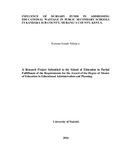| dc.description.abstract | Despite the implementation of secondary education bursary fund (SEBF) to minimize educational wastage from poor families, the country still experiences problems such as repetition and drop out of students in secondary schools (KIPPRA, 2007). This is an indication that despite the government’s continued to increase the bursary funds allocation from kshs.204.5 million in 1997/1998 financial year to kshs 400 million in 2006/2007 (IPAR,2008), large number of needy students do not access funds. This study therefore assessed the influence of bursary funds in addressing educational wastage in public secondary schools in kandara sub-county, in Murang’a County. Kenya government
is still increasing the amount allocated to bursary funds so that the country can achieve millennium development goals and vision 2030. The target population was all 20 secondary schools in Kandara sub-county while the sample size constituted of 310 students, 80 class teachers, 20 school principals and 10 CBF committee members. This was 45% of the target population. Data collection was done using questionnaires and interview schedule, while data analysis as done using descriptive statistics. From the study findings, the study concluded that majority of needy students come from poor economic backgrounds. The SEBF was critical source of funds for financing education as majority of parents did not have a stable source of income. The lack of school fees was the major contributing factor to educational wastage that is repetition and drop out of students in public secondary schools. The level of awareness on SEBF qualification criteria was very low in secondary schools in Kandara Sub-county. Majority of the families could not solely fund for secondary education for their children and therefore required external sources like SEBF to help in offsetting school fees balances. In Kandara sub-county (19.3%) had repeated classes due to lack of school fees and 20% drop out. This depicts that lack of school fees contributes to a greater percentage to educational wastage. From the findings some of the major problems experienced in Kandara subcounty is that majority of the students agreed that the amount allocated is too little, Amount always delays, and even when they apply they are not sure if they will be awarded. The most significant ways of improving SEBF disbursement to needy students were; Increasing SEBF allocations, strict adherence to the set Criteria, increasing the level of transparency in allocation to avoid bursary funds benefitting those who don’t deserve, also increasing the level of awareness to the targeted beneficiaries on the SEBF application procedures. The study recommends that the CDF committee should come up
with database where they will be regularly updating its applicants and beneficiaries to ensure that they are able to track their progress to enable them to complete their secondary education. Also SEBF management should scale up the amount of bursary allocated to each needy students to ensure suitability of their education. The government should monitor and evaluate criteria in place to ensure compliance by CBF committee in allocating SEBF, so that only deserving needy students’ benefits from the funds. | en_US |



